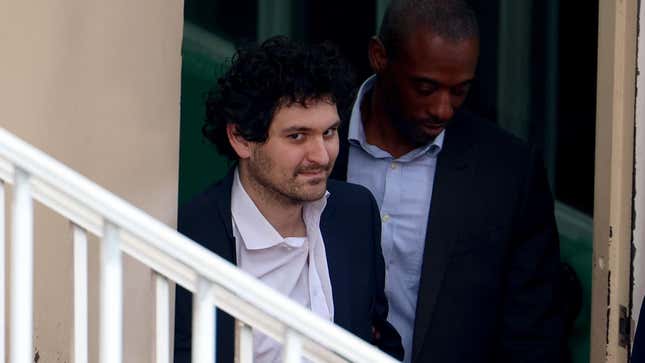
FTX, the once beloved crypto change that went down in a ball of financially malfeasant flames final November, seems to haven’t given a lot of a shit about defending its clients’ digital belongings.
Certainly, the corporate’s latest bankruptcy report reveals that, along with managing its funds like a cross between a Jim-Beam-swigging monkey and a debauched Roman emperor, the disgraced crypto change additionally apparently had among the worst cybersecurity practices possible.
Yep, this firm was simply asking to get hacked. And, in fact, it did.
Final November, lower than 24 hours after the corporate declared Chapter 11 chapter and never lengthy after its former chief, Sam Bankman-Fried (or, SBF) stepped down as CEO, the corporate suffered a large digital robbery during which some nonetheless unidentified fiend made off with $432 million in belongings, a bundle of digital money that’s nonetheless unaccounted for—similar to a whole lot more of FTX clients’ cash.
G/O Media might get a fee

Save $400
2021 14″ 1TB MacBook Pro
MacBook Pro’s are the way to go
Up to 10-core CPU delivers up to 3.7x faster performance to fly through pro workflows quicker than ever. Up to 32-core GPU with up to 13x faster performance for graphics-intensive apps and games
At the time, the hacking incident seemed like just more bad news on top of an already epic shit sundae, but now we have a little more context for the episode. Indeed, Monday’s report, which extensively reviews the company’s total failure to institute quite basic digital protections, is a comic masterpiece that will make you wonder how the company didn’t get hacked earlier.
“The FTX Group failed to implement basic, widely accepted security controls to protect crypto assets. Each failure was egregious in the context of a business entrusted with customer transactions,” the report states. Here are some of the takeaways about those failures.
FTX Didn’t Have a Security Staff
Despite being a company tasked with protecting tens of billions of dollars in crypto assets, FTX had no dedicated cybersecurity staff. None. Indeed, the company never bothered to hire a CISO (a chief info safety officer) to handle the corporate’s dangers for them. As an alternative, they relied on two of the corporate’s software program builders who, the report notes, didn’t have formal coaching within the area of safety and whose jobs put them at odds with prioritizing safety. The report states:
The FTX Group had no unbiased Chief Data Safety Officer, no worker with acceptable coaching or expertise tasked with fulfilling the duties of such a task, and no established processes for assessing cyber threat, implementing safety controls, or responding to cyber incidents in actual time…as with important controls in different areas, the FTX Group grossly deprioritized and ignored cybersecurity controls, a outstanding reality provided that, in essence, the FTX Group’s whole enterprise—its belongings, infrastructure, and mental property—consisted of laptop code and know-how.
Granted, a number of tech corporations undergo from staffing shortages on the subject of cybersecurity however that’s actually solely excusable in the event you’re a unicorn or a startup and don’t have the manpower or capital to rent competent folks. Within the days earlier than its implosion, FTX was reported to be price as a lot as $32 billion. Suffice it to say, I feel they might’ve employed a man.
FTX Fairly A lot By no means Used Chilly Storage
One other actually dumb factor that FTX did was fail to maintain its customers’ crypto belongings in chilly storage—an ordinary safety apply that the majority crypto exchanges declare to abide by.
On the whole, crypto belongings could be saved in two separate methods: “hot wallets,” that are software-based accounts linked to the web; and “cold storage,” which is an offline, hardware-based type of storage. Chilly storage is taken into account safe, whereas “scorching wallets” are riskier, as a result of—being linked to the net—they will (and infrequently do) get hacked.
Frequent knowledge means that corporations hold simply as a lot crypto in scorching wallets as essential to hold accounts liquid, whereas the remainder of the crypto ought to be saved in chilly storage. Nonetheless, FTX didn’t try this; as an alternative, the report says it saved “nearly all” of its clients’ belongings in scorching wallets.
Did FTX not know that chilly storage was safer or one thing? Nope, worse than being too silly to implement correct controls, the change’s management seems to have simply not given a lot of a shit.
“The FTX Group undoubtedly acknowledged how a prudent crypto change ought to function, as a result of when requested by third events to explain the extent to which it used chilly storage, it lied,” the report states, itemizing off various examples during which FTX executives—together with SBF—claimed that they saved customers’ belongings in chilly storage. In a single occasion, the corporate instructed buyers that, in step with trade greatest practices, it saved a small quantity of crypto in scorching wallets, whereas the remaining was “saved offline in air gapped encrypted laptops, that are geographically distributed.” However this was, in keeping with the report, simply bullshit.
As an alternative, because the report notes, “the FTX Group made little use of chilly storage” besides in Japan, “the place [it was] required by regulation to make use of” it.
Personal Keys Have been Left Unencrypted
One other completely idiotic factor that the FTX peeps did is hold purchasers’ delicate cryptographic keys and seed phrases saved in plaintext paperwork that had been apparently accessible by workers.
In crypto, the important thing or seed phrase is the password that will get you inside a person’s particular person pockets. Suffice it to say, trade requirements compel crypto exchanges to maintain that info encrypted and, thus, secure from prying eyes. Not so, with FTX—which apparently saved keys that might open wallets price tens of tens of millions of {dollars} unencrypted, in plaintext, simply mendacity round in AWS.
In keeping with the report, this was half and parcel of a usually disorganized strategy to safety, during which “personal keys and seed phrases utilized by FTX.com, FTX.US, and Alameda had been saved in numerous places all through the FTX Group’s computing setting in a disorganized vogue, utilizing a wide range of insecure strategies and with none uniform or documented process.”
The FTX Gang Didn’t Actually Use MFA
SBF and his merry band of hipsters additionally apparently “did not successfully implement the use” of multi-factor authentication—a really fundamental type of net safety that just about all people who works in an workplace is aware of about. The not too long ago launched report states that the crypto change’s management “did not implement in an acceptable vogue even essentially the most broadly accepted controls referring to Id and Entry Administration (“IAM”).” This included a failure to make use of MFA in addition to single-sign on providers—additionally broadly thought-about to be an trade greatest apply.
And far, way more!
Suffice it to say, there are plenty of different hilarious jewels of safety negligence that FTX seems to have dedicated, so I’d recommend studying the full report if you need your jaw to drop to the ground.
Trending Merchandise

Cooler Master MasterBox Q300L Micro-ATX Tower with Magnetic Design Dust Filter, Transparent Acrylic Side Panel…

ASUS TUF Gaming GT301 ZAKU II Edition ATX mid-Tower Compact case with Tempered Glass Side Panel, Honeycomb Front Panel…

ASUS TUF Gaming GT501 Mid-Tower Computer Case for up to EATX Motherboards with USB 3.0 Front Panel Cases GT501/GRY/WITH…

be quiet! Pure Base 500DX Black, Mid Tower ATX case, ARGB, 3 pre-installed Pure Wings 2, BGW37, tempered glass window

ASUS ROG Strix Helios GX601 White Edition RGB Mid-Tower Computer Case for ATX/EATX Motherboards with tempered glass…










